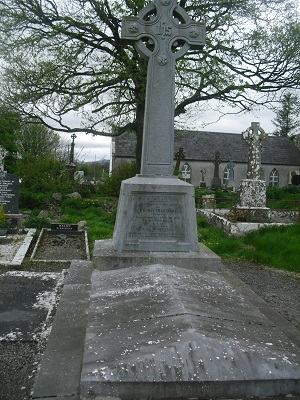 Michael Davitt’s grave in Straide, County Mayo. Towards the end of March 1906, the great Irish patriot, ‘Father of the Land League’, and social reformer, Michael Davitt, heard about a ‘painless dentist’ in Dublin and had a tooth extracted. Pleased with the experience, he returned a few days later and had more teeth removed, including the root of one which had been broken during his first imprisonment and had caused him some trouble. He later developed influenza and septic inflammation of his lower jaw, resulting in a big abscess, with an operation in his home to have it removed. After a month, a second operation became necessary, and he was removed to the Elpis Nursing Home, Lower Mount Street, Dublin, where an affected portion of his jaw-bone was removed on 15 May. Subsequently, Michael’s condition varied considerably, with regular bulletins on his condition issued by the hospital. On 28 May, a terse bulletin from the hospital stated, ‘Mr. Davitt has lost ground during the day and is in a most critical condition.’ On Tuesday 29 May, a hospital bulletin stated: ‘Mr. Davitt has been losing ground, but is free from pain, and is resting quietly.’ The following day’s bulletin was very ominous: ‘Mr. Davitt has lost ground since yesterday and continues in a most critical condition.’ Michael Davitt became unconscious and died early on Wednesday 30 May 1906, with his eldest son, Michael, and a few other friends at his bedside. His wife, who was suffering a miscarriage was a patient in an upper room of the same hospital, was unable to be present. The cause of death was septicaemia. His death came as a huge shock to his wife, family, friends and indeed everyone who knew or heard of him. After his death, there was a great desire among Irish nationalists for a public funeral, but his will contained a request for a very simple ceremony, with specific instructions as to where he was to be buried. It stated: "Should I die in Ireland, I would like to be buried at Straide, Co. Mayo, without any funeral demonstration. If I die in America, I must be buried in my mother’s grave at Manayunk, near Philadelphia, and on no account be brought back to Ireland; if in any other country (outside of Great Britain), to be buried in the nearest cemetery to where I may die, with the simplest possible ceremony. Should I die in Great Britain, I must be buried at Straide, Co. Mayo." His remains were moved to the Church of the Carmelite Fathers, St. Teresa’s, Clarendon Street, Dublin, on the evening of 31 May without any public notice. In January 1878, it had been the only Catholic Church in Dublin which did not refuse to accept the remains of his Fenian friend, Charles H. McCarthy, who died suddenly following his release from prison. As Michael Davitt was involved in the funeral arrangements, he never forgot the kindness and help he received from the Carmelite Fathers and could pay them no greater tribute than to request that his own body be brought there. Despite his own request for a private funeral, thousands filed past Davitt’s coffin in Clarendon Street church on the evening of his removal, the following day and on Saturday morning, 2 June. After Mass, his remains were removed from St. Teresa’s Church to Broadstone station on Saturday morning, 2 June 1906, for a train journey to his native county. People gathered all along the route to pay their own silent tributes as the train passed by. There was a big crowd awaiting the arrival of the train in Foxford, County Mayo, where a group of local farmers formed a guard of honour around the hearse as it started off for Straide, a short journey from there. Every horse-and-trap for miles around Foxford was there to carry those who came to pay their respects. There was a large crowd, including numerous clergy and public representatives, in the cemetery adjoining Straide Friary, where Michael Davitt was laid to rest within a half kilometre of the place where he was born just over sixty years before (his family home was knocked with a battering ram when they were evicted in October 1850. Michael was then four and half years old). A Celtic Cross was later erected over Michael Davitt’s grave in Straide, with an inscription to his memory in both English and Irish. The nearby Michael Davitt Museum, in the restored church where he was baptised in 1846, was opened in 2000. An earlier publication, a concise biography of Michael Davitt, entitled Davitt by Bernard O’Hara published in 2006 by Mayo County Council , is now available as Davitt: Irish Patriot and Father of the Land League by Bernard O’Hara, which was published in the USA by Tudor Gate Press (www.tudorgatepress.com) and is available from amazon.com and amazon.co.uk. It can be obtained as an eBook from the Apple iBookstore (for reading on iPad and iPhone), from Amazon.com and Amazon.co.uk (Kindle & Kindle Fire) and from Barnesandnoble.com (Nook tablet and eReader). Exploring Mayo by Bernard O’Hara is now available Worldwide as an eBook for the amazon Kindle application. The print version of Bernard O’Hara’s book Exploring Mayo can be obtained by contacting www.mayobooks.ie. www.mayobooks.ie also sell the print versions of Killasser - Heritage of a Mayo Parish , Anseo and Davitt. Bernard O'Hara's book entitled Killasser: Heritage of a Mayo Parish is now on sale in the USA and UK as a paperback book at amazon.com, amazon.co.uk or Barnes and Noble It is also available as an eBook from the Apple iBookstore (for reading on iPad and iPhone), from Amazon.com and Amazon.co.uk (Kindle & Kindle Fire) and from Barnesandnoble.com (Nook tablet and eReader). |